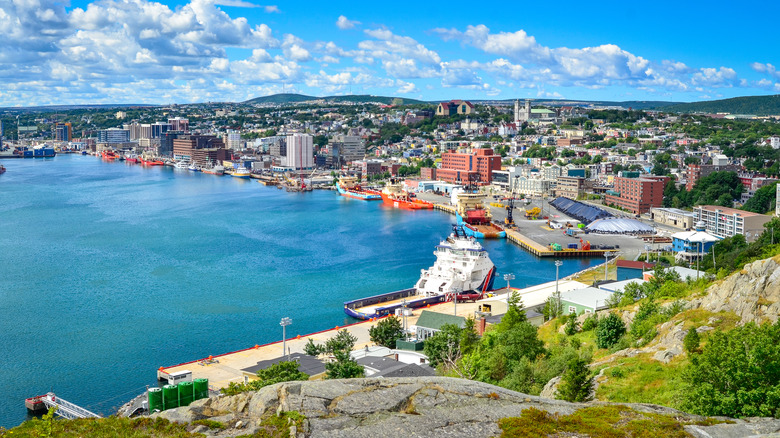The Canadian Destination Samantha Brown Says To Visit For European Culture And Experiences
While there are several locations across Canada that might have you feeling like you've been transported to Europe, the city of St. John's in Newfoundland takes the cake. Picture lighthouses clinging to rocky cliff sides, colorful row houses, and a distinctive European influence. As travel expert Samantha Brown put it on her website, "St. John's offers history, nature, wildlife, and culture." What more could you ask for?
Samantha Brown deemed St. John's as feeling like six different European countries wrapped into one. "Iceland, Ireland, Norway, England, France, and Denmark are travel destinations that are likely on your radar. But what if I told you that you could experience all of these cultures and environments in one place?" A singular destination that packs the punch of so many different European countries sounds almost too good to be true, but Newfoundland and Labrador has long been known for its unique culture and heritage that harkens back to European ancestry.
Of course, there are a few things you'll find in St. John's that might quickly remind you that you're in Canada after all. Icebergs float by lackadaisically, giant puffin colonies sit on the shores of the city, and Newfoundlanders are well known for their mega-friendly attitudes. Canada's majestic mountains and vibrant blue waters are at play here, too. Here's everything Samantha Brown wants you to know about visiting St. John's in Newfoundland and Labrador.
European culture and heritage in Newfoundland
While it might feel like the city of St. John's pulls from each of the destinations Samantha Brown likened it to, many islanders are the descendants of Irish immigrants, and you might find yourself comparing the region to the Emerald Isle. "You may notice there's an Irish vibe throughout Newfoundland ..." Brown wrote, "... especially on the coastline near St. John's. The Irish arrived here during the 17th and 18th centuries, first as summer workers for fish merchants, then as permanent settlers. You'll see that influence in the food, music, art, and culture here — especially in this historic village."
Nicknamed the "most Irish island in the world" by the Irish Times, Newfoundland's Celtic roots run deep. St. John's holds several festivals each year in celebration of its rich Irish heritage, including the quirky Mummer's Festival. Brought to Newfoundland by Irish and English immigrants, the tradition sees locals visit each other's houses, dressed in disguises. Similarly, the Séamus Creagh Festival takes place in St. John's each September and is an homage to Irish music and dance. Visitors can discover even more Irish culture by driving the Irish Loop, which happens to start in St. John's and visits other small villages along the Avalon Peninsula.
The European comparisons don't stop there. You could easily compare St. John's to the other destinations Brown mentioned. You'll find similar wildlife in Iceland, comparable climate in Norway and Denmark, and a French influence, too.
When is the best time to visit St. John's, Newfoundland?
According to Samantha Brown, August is the best time to visit this remote, maritime haven. Because Newfoundland can see wicked winter weather, you'll swoop in well before the first snowflakes fall and arrive just in time for whale and puffin season. Brown says, "A half-hour's drive south of St John's, you'll find the summer home of 2.5 million seabirds and the largest Atlantic puffin colony in North America. It's also a notable whale-watching site." Newfoundland's significant whale population returns to the icy waters off the coast between May and September each year.
Keep in mind that if you want to visit Newfoundland for its other famous sights like icebergs, you'll need to choose when to visit wisely. Huge icebergs float by this Canadian coastal destination in the spring and early summer, which can be tracked via Newfoundland's official "Iceberg Finder" website. These frozen giants even sail right past St. John's at times. While it's rare to witness them in the late summer months, you might be able to catch a glimpse along the coast of Labrador in early August.
The climate in St. John's, and for much of Newfoundland, is considered to be temperate marine, but many would consider the winters to be a bit extreme. Newfoundland is a fairly rugged destination and sees equally rugged weather. The island is known for its legendary storms, from thick fog to powerful Nor'easters that gain steam as they head up the coast from the U.S.


